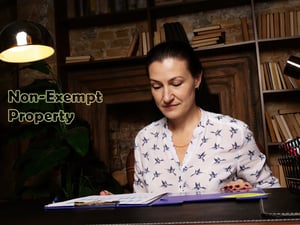 Unlike a chapter 13 bankruptcy case in which the debtor makes payments to creditors in a three to five year payment plan before receiving a discharge, a chapter 7 requires no payments to any creditors, and involves a discharge a mere few months after the case is filed. However, while the debtor gets to keep all their property in a chapter 13 case, this is not always so in a chapter 7 case. In the majority of chapter 7 cases, the debtor gets to keep all their property due to the fact it is “exempt”, or legally protected from being taken to pay creditors. However, in some chapter 7 cases, the debtor has certain nonexempt property that they must either surrender to the trustee to be liquidated (sold with proceeds going to pay creditors) or, alternatively, must be paid for by the debtor for their right to keep the nonexempt property. Any money paid by the debtor to keep nonexempt property likewise goes to pay creditors.
Unlike a chapter 13 bankruptcy case in which the debtor makes payments to creditors in a three to five year payment plan before receiving a discharge, a chapter 7 requires no payments to any creditors, and involves a discharge a mere few months after the case is filed. However, while the debtor gets to keep all their property in a chapter 13 case, this is not always so in a chapter 7 case. In the majority of chapter 7 cases, the debtor gets to keep all their property due to the fact it is “exempt”, or legally protected from being taken to pay creditors. However, in some chapter 7 cases, the debtor has certain nonexempt property that they must either surrender to the trustee to be liquidated (sold with proceeds going to pay creditors) or, alternatively, must be paid for by the debtor for their right to keep the nonexempt property. Any money paid by the debtor to keep nonexempt property likewise goes to pay creditors.
Bankruptcy is not designed to leave the debtor destitute. That’s why the law allows the debtor to legally exempt, and protect, property necessary for their basic needs, such as a home, a modest vehicle, clothing, furniture, and household goods. Property that is commonly nonexempt includes things like boats, extra vehicles, a second home/cabin, ATVs, large tax refunds, and excessive money in a bank account. Debtors in Minnesota have the option of choosing between using the “Federal Exemptions” specifically from the Bankruptcy Code, or “State Exemptions,” which include any other available exemptions under State or Federal law not included in the Bankruptcy Code.
Debtors with little to no equity in their home often choose Federal Exemptions, which enables them to keep most, if not all, of their property. This is because the Federal Exemptions provide a “wild card” exemption that can be used to protect property that would otherwise be nonexempt (i.e. an ATV or large tax refund). The wild card exemption can be up to $13,900 depending on the amount of equity in the debtor’s home (the greater the amount of equity in the home, the less this wild card amount becomes). However, debtors with a significant amount of equity in their home may need to use State Exemptions in order to protect their home. This is because the Federal Exemptions only provide an exemption amount of $25,150 to protect in home equity, while the State Exemptions provide an exemption of up to $450,000 to protect equity in the home. Since the State Exemptions do not provide for a wild card to protect property that is not specifically exempted under another State or Federal Statute, in most of these cases, the debtor will likely have some property that is nonexempt.
About a month, or so, after a debtor files a chapter 7 case, a creditor’s meeting (aka a 341 meeting) takes place, in which the trustee interviews the debtor to confirm the accuracy of the information in their petition, and other relevant documents, and determines whether more information or documentation are required. When the creditor’s meeting has concluded the trustee will inform the debtor, or the debtor’s bankruptcy attorney if they are so represented, on whether they intend to pursue any of the debtor’s nonexempt property. In some cases where the amount of nonexempt property is small, the trustee may opt to not pursue the property due to the fact that the process the trustee must undertake to take the property and distribute it to creditors is not worth the amount received. For example, the trustee must file notice to creditors to file claims requesting payment, negotiate a settlement for payment with the debtor, take possession property not in cash form (i.e. a boat) to auction off and liquidate, and account for all costs and funds distributed to creditors. This process is known as “administering the estate.” The trustee themselves usually only receives a small percentage of the total proceeds, typically 25%, as compensation for administering the estate.
If the trustee does decide to pursue the nonexempt property and administer the estate, the debtor, or their attorney, will have to negotiate how to “settle,” or negotiate the turnover of the nonexempt property, with the trustee. As stated before, the debtor has the option of either letting the trustee take the nonexempt property to pay creditors or pay the trustee for the right to keep it. Trustees will typically not negotiate the amount of nonexempt property that is in cash form, such as cash in the bank or tax refunds. The debtor is usually required to turn over any such amount of such non-cash property to the trustee. However, for property not in cash form (i.e. a boat) which must be taken and liquidated into cash, the trustee is usually willing to settle with the debtor and allow the debtor to pay the trustee less than the actual value of the property in order for the debtor to keep it. Once a settlement is reached, the trustee will draft a formal settlement agreement to be filed with the court, which is filed by Court Order approving the settlement. Both the trustee and debtor are bound by the terms of this agreement, and the debtor must comply with such terms in order to ensure they receive, and keep, their discharge.
CALL NOW FOR A FREE STRATEGY SESSION FROM A MN BANKRUPTCY LAWYER AT LIFEBACK LAW FIRM
This is a very brief overview of the complex topic of how nonexempt property is handled in a chapter 7 bankruptcy. It is very prudent for a person considering filing for bankruptcy to discuss their particular case with a bankruptcy attorney before filing their case. An experienced bankruptcy attorney can give them the best advise them on what, if any, property will be considered exempt vs. nonexempt, and if they represent them in their case, can give them the best opportunity for working out a great settlement with the trustee for any nonexempt assets. See us at LifeBackLaw.com!


